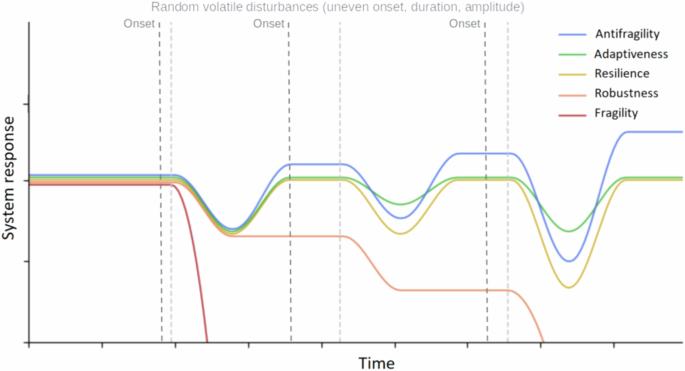Antifragility in complex dynamical systems
引用次数: 0
Abstract
Antifragility characterizes the benefit of a dynamical system derived from the variability in environmental perturbations. Antifragility carries a precise definition that quantifies a system’s output response to input variability. Systems may respond poorly to perturbations (fragile) or benefit from perturbations (antifragile). In this manuscript, we review a range of applications of antifragility theory in technical systems (e.g., traffic control, robotics) and natural systems (e.g., cancer therapy, antibiotics). While there is a broad overlap in methods used to quantify and apply antifragility across disciplines, there is a need for precisely defining the scales at which antifragility operates. Thus, we provide a brief general introduction to the properties of antifragility in applied systems and review relevant literature for both natural and technical systems’ antifragility. We frame this review within three scales common to technical systems: intrinsic (input–output nonlinearity), inherited (extrinsic environmental signals), and induced (feedback control), with associated counterparts in biological systems: ecological (homogeneous systems), evolutionary (heterogeneous systems), and interventional (control). We use the common noun in designing systems that exhibit antifragile behavior across scales and guide the reader along the spectrum of fragility–adaptiveness–resilience–robustness–antifragility, the principles behind it, and its practical implications.

复杂动力系统中的反脆弱
反脆弱度描述了动态系统从环境扰动变化中获得的益处。反脆弱有一个精确的定义,可以量化系统对输入变化的输出响应。系统对扰动的反应可能很差(脆弱),也可能从扰动中受益(反脆弱)。在本手稿中,我们回顾了反脆弱理论在技术系统(如交通控制、机器人)和自然系统(如癌症治疗、抗生素)中的一系列应用。虽然各学科量化和应用反脆弱性的方法存在广泛的重叠,但仍有必要精确定义反脆弱性发挥作用的尺度。因此,我们简要介绍了应用系统中反脆弱性的特性,并回顾了自然和技术系统反脆弱性的相关文献。我们在技术系统常见的三个尺度范围内进行回顾:内在(输入-输出非线性)、继承(外在环境信号)和诱导(反馈控制),以及生物系统中的相关对应尺度:生态(同质系统)、进化(异质系统)和干预(控制)。我们在设计跨尺度表现出反脆弱行为的系统时使用了常用名词,并引导读者沿着脆弱性--适应性--复原性--稳健性--反脆弱的光谱,了解其背后的原理及其实际意义。
本文章由计算机程序翻译,如有差异,请以英文原文为准。
求助全文
约1分钟内获得全文
求助全文

 求助内容:
求助内容: 应助结果提醒方式:
应助结果提醒方式:


